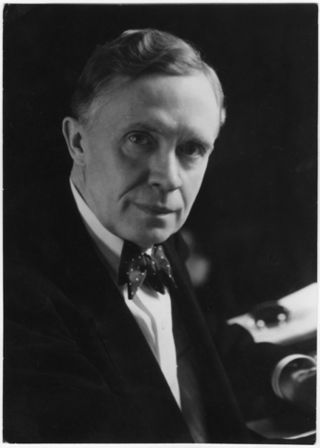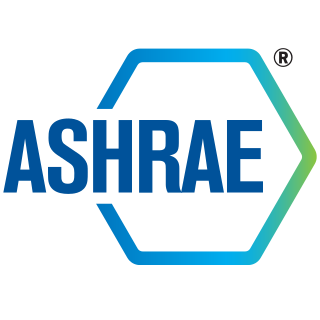
Heating, ventilation, and air conditioning (HVAC) is the use of various technologies to control the temperature, humidity, and purity of the air in an enclosed space. Its goal is to provide thermal comfort and acceptable indoor air quality. HVAC system design is a subdiscipline of mechanical engineering, based on the principles of thermodynamics, fluid mechanics, and heat transfer. "Refrigeration" is sometimes added to the field's abbreviation as HVAC&R or HVACR, or "ventilation" is dropped, as in HACR.
A sound attenuator, or duct silencer, sound trap, or muffler, is a noise control acoustical treatment of Heating Ventilating and Air-Conditioning (HVAC) ductwork designed to reduce transmission of noise through the ductwork, either from equipment into occupied spaces in a building, or between occupied spaces.
ISO 13567 is an international computer-aided design (CAD) layer standard.
The stack effect or chimney effect is the movement of air into and out of buildings through unsealed openings, chimneys, flue-gas stacks, or other containers, resulting from air buoyancy. Buoyancy occurs due to a difference in indoor-to-outdoor air density resulting from temperature and moisture differences. The result is either a positive or negative buoyancy force. The greater the thermal difference and the height of the structure, the greater the buoyancy force, and thus the stack effect. The stack effect helps drive natural ventilation, air infiltration, and fires.

Ducts are conduits or passages used in heating, ventilation, and air conditioning (HVAC) to deliver and remove air. The needed airflows include, for example, supply air, return air, and exhaust air. Ducts commonly also deliver ventilation air as part of the supply air. As such, air ducts are one method of ensuring acceptable indoor air quality as well as thermal comfort.
The Federation of Environmental Trade Associations (FETA) is a UK body which represents the interests of manufacturers, suppliers, installers and contractors within the refrigeration, heating, ventilating, and air conditioning industry. It is based in Hare Hatch near Wokingham.

The Sheet Metal and Air Conditioning Contractors' National Association is an international trade association with more than 4,500 contributing contractor members in 103 chapters throughout the United States, Canada, Australia and Brazil. Its headquarters is in Chantilly, Virginia.

The Chartered Institution of Building Services Engineers is an international professional engineering association based in London, England that represents building services engineers. It is a full member of the Construction Industry Council, and is consulted by government on matters relating to construction, engineering and sustainability. It is also licensed by the Engineering Council to assess candidates for inclusion on its Register of Professional Engineers.
Hoare Lea is a UK-based, multi-disciplinary engineering consultancy firm, specialising in building services. The firm works with clients from the detailed design stage right through to delivery.
Building services engineering (BSE) is a professional engineering discipline that strives to achieve a safe and comfortable indoor environment whilst minimizing the environmental impact of a building.
BSRIA is a UK-based testing, instrumentation, research and consultancy organisation, providing specialist services in construction and building services engineering. It is a not-for-profit, member-based association, with over 650 member companies; related services are delivered by a trading company, BSRIA Limited. Any profits made are invested in its research programme, producing best practice guidance.

Mechanical systems drawing is a type of technical drawing that shows information about heating, ventilating, air conditioning and transportation around the building. It is a powerful tool that helps analyze complex systems. These drawings are often a set of detailed drawings used for construction projects; it is a requirement for all HVAC work. They are based on the floor and reflected ceiling plans of the architect. After the mechanical drawings are complete, they become part of the construction drawings, which is then used to apply for a building permit. They are also used to determine the price of the project.

ECA is the main trade association for companies involved in electrotechnical and other technical engineering projects in England, Northern Ireland and Wales. In 2022 it had some 2600 registered members - companies who collectively generated annual revenues of over £6billion. ECA also has associate categories open to industry manufacturers, distributors, educators, clients and specifiers who wish to engage and collaborate with members.

Arthur Cutts Willard was the ninth president of the University of Illinois and an innovator in the field of heating and ventilation. Known for being approachable, a gentleman and well-dressed; he was known and admired by many. He received worldwide acclaim for his research and contribution to the heating, ventilating field; in particular for his contributions to the Holland Tunnel. In addition to his contributions to heating and ventilation industry, Willard was an educator in heating and ventilation and mechanical engineering between 1906 and 1933. He taught at George Washington University and the University of Illinois. Willard was appointed president in 1934 and served until 1946. Although he served as president during a difficult time for the university and the nation, he continued to have the highest expectations of his students. During his time as president he obtained funding for construction and addition of many buildings on the University of Illinois campuses. Willard strongly believed education needed to be more broad and focus on the social and economic problems facing the nation. At the end of service to the university, the Institute of Aviation was established at University of Illinois Willard Airport, and it was named in honor of A.C. Willard.

SELECT, founded in 1900 as the Electrical Contractors' Association of Scotland, is the Scottish construction trade association for specialist businesses in the electrical industry.
Sigurd Max Fordham OBE RDI FREng FCIBSE Hon FRIBA was a British designer, engineer and pioneer of sustainable design and environmentally friendly engineering. He was the founder of building services engineering firm Max Fordham LLP.
The Uniform Mechanical Code (UMC) is a model code developed by the International Association of Plumbing and Mechanical Officials (IAPMO) to govern the installation, inspection and maintenance of HVAC and refrigeration systems. It is designated as an American National Standard.

The American Society of Heating, Refrigerating and Air-Conditioning Engineers is an American professional association seeking to advance heating, ventilation, air conditioning and refrigeration (HVAC&R) systems design and construction. ASHRAE has over 50,000 members in more than 130 countries worldwide.
BESA TR19 are the duct-work cleaning guidelines provided by Building Engineering Services Association (BESA) for internal cleanliness of ventilation systems. The guidelines were introduced in 2005 by amalgamation of pre-existing TR/17 and DW/TM2 guidelines. Once a system is TR19 compliant, it has been found that average total High Risk Combustion Load Levels (HR-CLLs) can be reduced by a total of 83%.
Thermotank was a Scottish engineering company specialising in heating, ventilation and air conditioning, founded in Glasgow in 1900 by Alexander William Stewart and his two brothers William and Frederick. The business was based on Alexander’s invention, the Thermotank, a system designed for maritime use which could maintain a constant temperature coupled to a change of air on board ships.









